Hyksos › Egyptian Medicine » Ancient origins
Articles and Definitions › Contents
- Hyksos › Antique Origins
- Egyptian Medicine › Ancient History
Ancient civilizations › Historical and archaeological sites
Hyksos › Antique Origins
Definition and Origins
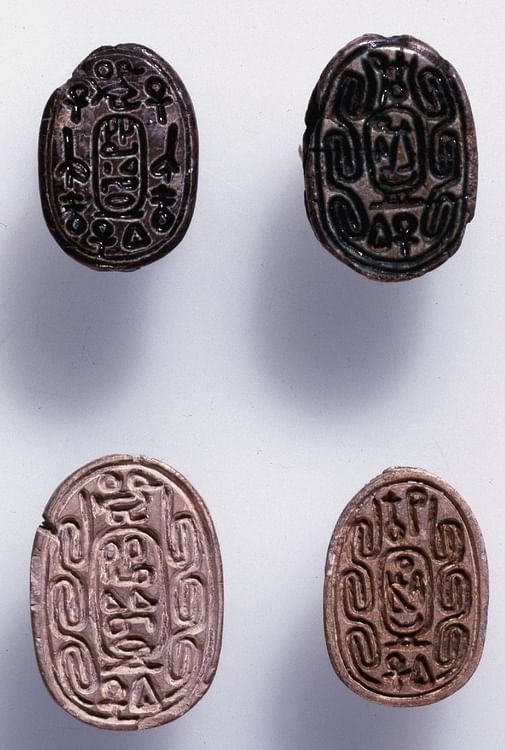
The Hyksos were a Semitic people who gained a foothold in Egypt c. 1782 BCE at the city of Avaris in Lower Egypt, thus initiating the era known in Egyptian history as the Second Intermediate Period (c. 1782 - c. 1570 BCE). Their name, Heqau-khasut, translates as 'Rulers of Foreign Lands' (given by the Greeks as Hyksos ), suggesting to some scholars that they were kings or nobility driven from their homes by invasion who found refuge in the port city of Avaris and managed to establish a strong power base during the decline of the 13th Dynasty of the Middle Kingdom (2040-1782 BCE). Most likely, they were traders who were at first welcomed at Avaris, prospered, and sent word to their friends and neighbors to come join them, resulting in a large population which was able to finally exert political and then military power.
Although the later Egyptian scribes of the New Kingdom (c. 1570-1069 BCE) would demonize the Hyksos as 'invaders' who conquered the land, destroyed temples, and slaughtered without mercy, there is no evidence for any of these claims. Even today, the Hyksos are referred to as invaders and their advent in Egypt as the 'Hyksos Invasion,' but actually, they assimilated neatly into Egyptian culture adopting Egyptian fashion and religious beliefs, with some modifications, as their own. Contrary to many claims throughout the years, there is no reason to identify the Hyksos with the Hurrians nor with the Hebrew slaves from the biblical Book of Exodus.
The main source of information on the Hyksos in Egypt comes from the 3rd century BCE Egyptian writer Manetho whose work has been lost but was extensively quoted by later writers, notably Flavius Josephus (37- c. 100 CE). Manetho's flawed understanding of the meaning of the Hyksos' name, and Josephus' further misinterpretation gives the translation of 'Hyksos' as 'captive shepherds,' and this complete misunderstanding has given rise in recent years to the claim that the Hyksos were a Hebrew community living in Egypt whose expulsion provides the basis for the events recorded in the Book of Exodus. There is no evidence, however, to support this claim. No Egyptian, nor any other culture's, records indicate the Hyksos were slaves in Egypt, and there is absolutely no indication they were Hebrew, only that they spoke and wrote a Semitic language. The ethnic origins of the Hyksos are unknown as is their fate once they were driven from Egypt by Ahmose I of Thebes (c. 1570-1544 BCE) who initiated the era of the New Kingdom of Egypt (c. 1570-1069 BCE).
THE ARRIVAL OF THE HYKSOS
For the greater part of Egypt's history, the country was insular even though foreigners regularly came to work in the country, serve as mercenaries, or were taken as slaves for the gold mines. Egyptians lived in the land of the gods, and those of lesser quality (regularly referred to as 'Asiatics') were off beyond the borders. The popular story of The Contendings of Horus and Setfrom the New Kingdom relates how, once the god Set is bested by Horus, he is given a kind of consolation prize of ruling over the desert regions beyond Egypt's borders. Set had murdered his brother, the god-king Osiris, and usurped the rule of Egypt.Osiris was brought back to life by his sister-wife Isis who bore his son Horus, the god who would eventually avenge his father and restore order to the land. The story's conclusion of placing Set outside of Egypt's borders is significant because Set was considered the god of chaos, darkness, storms and winds, and the Egyptians would have wanted such a deity as far from them as possible; out in the wilds where the 'other people,' the 'Asiatics,' would get the kind of god they deserved.
THE HYKSOS GAINED CONTROL OF THE EASTERN DELTA COMMERCIALLY & THEN MOVED NORTH MAKING TREATIES & FORGING CONTRACTS IN LOWER EGYPT UNTIL THEY WERE ABLE TO EXERT POLITICAL POWER.
Early campaigns by the Egyptian military, up until the time of the New Kingdom, were domestic for the most part, and when Egyptians did travel beyond their borders, it was never far. When the Hyksos first arrived, therefore, they would not have posed any great danger to Egyptian security because an actual threat from outside the country was simply unthinkable. By c.1782 BCE, Egypt had developed as a civilization for over 2,000 years, and the possibility of a people taking their country would have been dismissed as easily as a full-scale invasion of earth by flying saucers from Mars would be by most people today.
When the period of the Middle Kingdom began, Egypt was a strong, unified country. The king Amenemhat I (1991-1962 BCE), who founded the 12th Dynasty, was a strong, effective, ruler who, perhaps in an effort to further unify the country, moved the capital from Thebes (in Upper Egypt) to a middle ground between Upper and Lower Egypt near Lisht and named his new city Iti-tawi (also Itj-tawi ) which means "Amenemhat is he who takes possession of the Two Lands" (van de Mieroop, 101). He also founded the town of Hutwaret in Lower Egypt as a port of trade. Hutwaret (better known as Avaris, the Greek name) had access to the Mediterranean Sea and overland routes to the region of Syria - Palestine.
The 12th Dynasty is considered by many the high point of Egyptian culture and gives the Middle Kingdom its reputation as the 'classical age' of Egypt. The 13th Dynasty, however, was not as strong and made a number of ill-advised decisions which weakened their influence. The first of these mistakes was to move the capital from Iti-tawi back to Thebes in Upper Egypt. This decision essentially left Lower Egypt open to whatever power felt it had enough support to dominate it. The port town of Avaris, quickly expanding into a small city through commerce, attracted many of the people known to the Egyptians as 'Asiatics,' and as it flourished, their population grew. The Hyksos gained control of the eastern Delta commercially and then moved north making treaties and forging contracts with various nomarchs (governors) of other regions in Lower Egypt until they had taken a sizeable amount of the land and were able to exert political power.
THE HYKSOS IN EGYPT
Contrary to the claims of New Kingdom scribes, Manetho, Josephus - and even later historians of the 20th century CE - the Second Intermediate Period of Egypt was not a time of chaos and confusion, and the Hyksos did not conquer the whole of Egypt. Their influence extended only as far south as Abydos, and in the region of Lower Egypt, there were many cities, like Xois, which maintained their autonomy. The ruling class of Xois founded the Xoite Dynasty (the 14th Dynasty of Egypt) during the time of the Hyksos and traded regularly with both them and Thebes.
Josephus' account, relying heavily on Manetho's (who drew on the New Kingdom scribes) gives the impression that the Hyksos rolled into Egypt in their war chariots, laying waste to the land, and toppling the legitimate government. Again, there is no evidence for this; Egyptologist and historian Margaret Bunson explains:
The Hyksos did enter Egypt, but they did not appear there suddenly, with what Manetho termed "a blast of God".The Hyksos entered the Nile region gradually over a series of decades until the Egyptians realized the danger they posed in their midst. Most of the Asiatics came across Egypt's borders for centuries without causing much of a stir. (119)
Once they were established at Avaris, the Hyksos placed Egyptians in significant positions, adopted Egyptian custom and dress, and incorporated the worship of Egyptian gods into their own beliefs and rituals. Their chief gods were Baal and Anat, both of Phoenician/Canaanite/Syrian origin, but they identified Baal with the Egyptian Set.
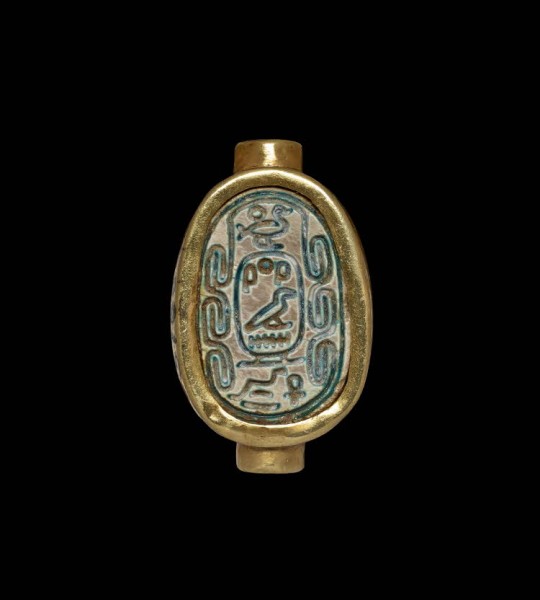
Cartouche of Khyan
The Hyksos rulers founded the 15th Dynasty of Egypt, but after they were expelled, all traces of the Hyksos in Egypt were erased by the conquering Thebans. Only a few Hyksos kings are known by name from the ruins of inscriptions, and other writings, found at Avaris and beyond: Sakir-Har, Khyan, Khamudi, and the best known, Apepi. Apepi was also known as Apophis and interestingly has an Egyptian name associated with the great serpent Apophis/Apep, enemy of the sun god Ra.It is possible that this king, who allegedly initiated the conflict between Avaris and Thebes, was so named by later scribes to associate him with danger and darkness.
There is nothing in the evidence which suggests that Apepi was either of those things. Trade flourished during the time of the Hyksos. Local governors of the cities and towns of Lower Egypt made treaties with the Hyksos, enjoyed profitable trade, and even Thebes, consistently depicted as the "last holdout" of Egyptian culture standing alone against the invader, had a cordial and seemingly profitable relationship with them, even though it does seem that Thebes paid tribute to Avaris.
AVARIS, THEBES & WAR
At the same time the Hyksos were gaining power in northern Egypt, the Nubians were doing so to the south. The 13th Dynasty of the Middle Kingdom had neglected to pay attention to their southern border just as they had with Lower Egypt. Thebes remained the capital of Upper Egypt but, instead of ruling the entire country, was sandwiched between the Hyksos in the north and the Nubians in the south. Still, Thebes and Avaris got along quite well. The Thebans were free to trade to the north, and the Hyksos sailed their ships past Thebes to buy and sell to the Nubians in the south. Trade went on between the Nubian capital of Kush, the Egyptian center at Thebes, and Avaris quite evenly until the Hyksos king - wittingly or unwittingly - insulted the king of Thebes.
There is no telling whether the story is true as given, but according to Manetho, Apepi of the Hyksos sent a message to the Theban king Seqenenra Taa (also known as Ta'O (c. 1580 BCE): "Do away with the hippopotamus pool which is on the east of the city, for they prevent me sleeping day and night." The message most likely had to do with the Theban practice of hippopotamus hunting, which would have been offensive to the Hyksos who incorporated the hippo in their religious observances through their worship of Set. Instead of complying with the request, Ta'O interpreted it as a challenge to his autonomy and marched on Avaris. His mummy shows he was killed in battle and this, and the events which follow, suggests the Thebans were defeated in this engagement.
Ta'O's son Kamose took up the cause, complaining bitterly in an inscription that he was tired of paying "the Asiatics" taxes and having to deal with foreigners to the north and south of him in his own land. He launched a massive strike against the Hyksos in which, according to his own account, Avaris was destroyed. Kamose claims that his attack was so swift and terrifying it made the Hyksos women suddenly sterile, and after the slaughter, he razed the city to the ground. This account would seem to be something of an exaggeration since the Hyksos still held Lower Egypt in the three years following Kamose's offensive and Avaris still stood as the Hyksos stronghold.
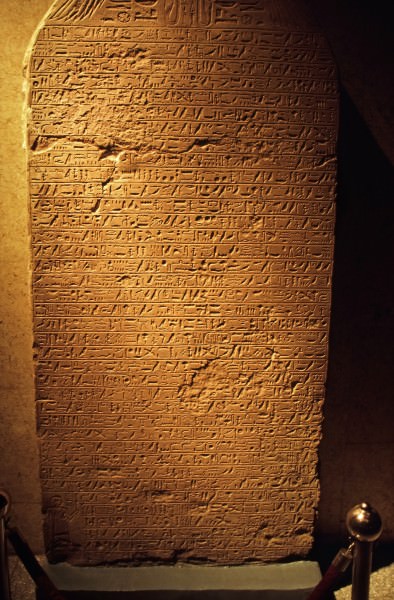
Stela of Kamose
Kamose was succeeded by his brother Ahmose, whose inscriptions describe how he drove the Hyksos from Egypt and destroyed their city of Avaris. These events are given in the tomb inscriptions of another man, Ahmose son of Ibana, a soldier who served under the king Ahmose, describing the destruction of Avaris and the flight of the surviving Hyksos to Sharuhen in the region of Palestine. This city was then placed under siege by Ahmose for six years until the Hyksos fled again, this time to Syria, but what happened to them after that is not recorded.
THE LEGACY OF THE HYKSOS IN EGYPT
Ahmose I not only founded the 18th Dynasty but initiated the period of the New Kingdom of Egypt, the era of the Egyptian empire. The development of a professional Egyptian army of conquest can be directly traced to the Hyksos in that Ahmose I, and those who followed him, wanted to make sure no foreign people would ever be able to gain such power in their land again.Beginning with Ahmose, and continuing on throughout the New Kingdom, the pharaohs created and maintained a buffer zone around Egypt which then encouraged them to conquer more lands beyond.
The Hyksos were vilified by the New Kingdom scribes to justify these wars of conquest and a new version of history was created in which the foreign invaders destroyed the temples of the gods, slaughtering the innocent and razing cities in a barbaric lust for conquest. Besides the fact that none of that happened, if it were not for the Hyksos, the Egyptian army would have been without two advantages which helped them establish their empire : the composite bow and the horse-drawn chariot.
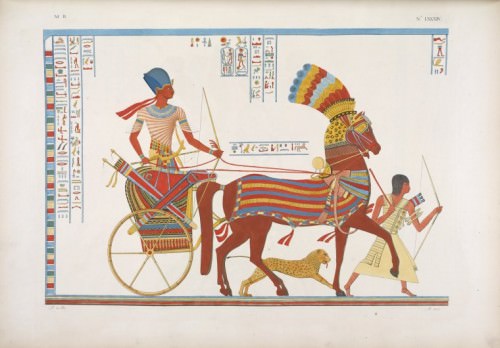
Egyptian War Chariot
Egyptian art from the New Kingdom regularly depicts the pharaoh, kings such as Tutankhamun or Ramesses II, in their chariot hunting with their dogs or going to war, and since the New Kingdom is the period most familiar to people in the present day, the chariot is associated with Egypt. The Egyptians had no knowledge of it, however, until it was introduced by the Hyksos. The composite bow, with much greater range and accuracy, replaced the Egyptian long bow that had been in use for centuries and the Hyksos also introduced the bronze dagger, the short sword, and many other innovations. New methods of crop irrigation were introduced to Egypt as well as metalworking in bronze. An improved potter's wheel resulted in higher quality ceramics which were also more durable. The Hyksos also brought to Egypt the vertical loom, which produced better quality linen, and new fruit and vegetable cultivation techniques.
The innovations of the Hyksos transformed the culture of Egypt but they also preserved the past. Under Apepi, old papyrus scrolls were copied and carefully stored and many of these are the only extant copies to have survived. They also united Egypt as never before through their depiction by New Kingdom scribes as blood-thirsty conquerors who had invaded the land of the gods. Egyptian nationalism was at an all-time high throughout most of the period of the New Kingdom, and aside from the new and improved weapons, Egypt's empire could never have risen without the belief that conquest was necessary to protect the people of Egypt from another tragedy which might be even more terrible than the invasion of the Hyksos.
Egyptian Medicine › Ancient History
Definition and Origins

Medical practice in ancient Egypt was so advanced that many of their observations, policies, and commonplace procedures would not be surpassed in the west for centuries after the fall of Rome and their practices would inform both Greek and Roman medicine. They understood that disease could be treated by pharmaceuticals, recognized the healing potential in massage and aromas, had male and female doctors who specialized in certain specific areas, and understood the importance of cleanliness in treating patients.
In the modern day it is recognized that disease and infection can be caused by germs and one might think people have always believed so but this is a relatively late innovation in human understanding. It was not until the 19th century CE that the germ theory of disease was confirmed by Louis Pasteur and proven by the work of British surgeon Joseph Lister.
Before either of them, the Hungarian physician Ignaz Semmelweis (1818-1865 CE) offered the then outlandish proposal to the medical community that they could cut mortality rates in their practices simply by washing their hands. He was mocked by doctors, who saw no reason to wash their hands before even the most invasive surgical procedures, and grew increasingly frustrated and bitter. Semmelweis was committed to a mental institution in 1865 CE where he died, after being severely beaten by guards, for suggesting a practice recognized as common sense today.
THE MORTALITY RATE FOLLOWING MEDICAL PROCEDURES IN ANCIENT EGYPT WAS PROBABLY LESS THAN THAT OF ANY EUROPEAN HOSPITAL IN THE CHRISTIAN ERA UNTIL THE MID-20TH CENTURY CE.
The ancient Egyptians would have accepted Semmelweis' proposal without hesitation; not because they understood the concept of germs, but because they valued cleanliness. The mortality rate following medical procedures in ancient Egypt was probably less than that of any European hospital in the Christian era until the mid-20th century CE when personal cleanliness and the sterilization of instruments became common practice.
Egyptologist Barbara Watterson notes that "medicine in ancient Egypt was relatively advanced and Egyptian doctors, who were all, with one or two exceptions, male, were skilled (46). Even so, for a civilization which regularly dissected the dead for embalming, doctors had little understanding of how most of the internal organs worked and blamed disease on supernatural forces.
INJURY & DISEASE
Injuries were easy to understand in ancient Egypt; disease was a bit more difficult. When someone was injured there was a plain cause and an effect which could then be treated; when a person was sick, however, the cause was less clear and so diagnosis more problematic.
The cause of disease was usually understood as the consequence of sin and, when that seemed not the case, that the patient was under a demonic attack, was being plagued by an angry ghost, or that some god felt they needed to learn a lesson.Disease, therefore, was commonly treated through recitation by a doctor of magical spells. Watterson notes, "the earliest 'doctor' was a magician, for the Egyptians believed that disease and sickness were caused by an evil force entering the body" (65).
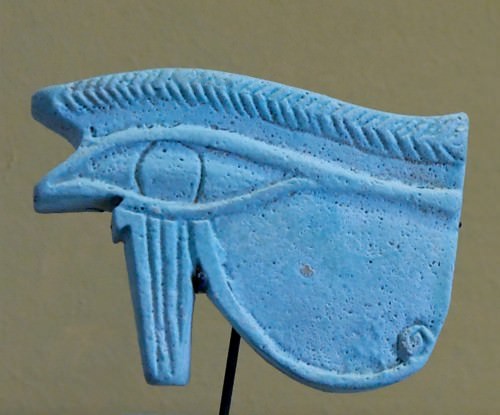
Eye of Horus
The types of diseases Egyptians suffered from were as numerous and varied as they are in the present day and included bilharsiasis (a disease contracted and spread through contaminated water); trachoma (an infection of the eye); malaria;dysentery; smallpox; pneumonia; cancer; heart disease; dementia; typhoid; arthritis; high blood pressure; bronchitis;tuberculosis; appendicitis; kidney stones; liver disease; curvature of the spine; the common cold, and ovarian cysts.
Besides magical spells, ancient Egyptians used incantations, amulets, offerings, aromas, tattoos, and statuary to either drive away the ghost or demon, placate the god or gods who had sent the illness, or invoke protection from a higher power as a preventative. The spells and incantations were written down on papyrus scrolls which became the medical texts of the day.
THE MEDICAL TEXTS
Although there were no doubt many more texts available in ancient Egypt, only a few have survived to the present. These few, however, provide a wealth of information on how the Egyptians saw disease and what they believed would alleviate a patient's symptoms or lead to a cure. They are named for the individual who owned them or the institution which houses them. All of them, to greater or lesser degrees, rely on sympathetic magic as well as practical technique.
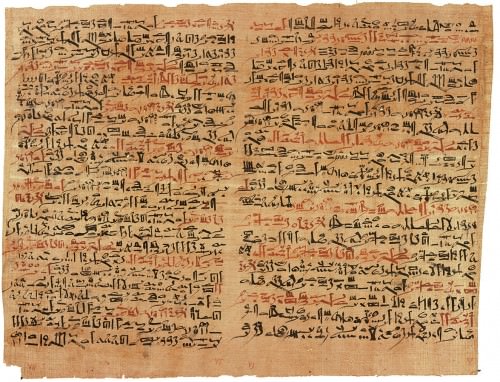
Edwin Smith Papyrus
The Chester Beatty Medical Papyrus, dated c. 1200 BCE, prescribes treatment for anorectal disease (problems associated with the anus and rectum) and prescribes cannabis for cancer patients (pre-dating the mention of cannabis in Herodotus, long thought to be the earliest mention of the drug). The Berlin Medical Papyrus (also known as the Brugsch Papyrus, dated to the New Kingdom, c. 1570 - c. 1069 BCE) deals with contraception, fertility, and includes the earliest known pregnancy tests.The Ebers Papyrus (c. 1550 BCE) treats cancer (for which, it says, there is no treatment), heart disease, diabetes, birth control, and depression. The Edwin Smith Papyrus (c. 1600 BCE) is the oldest work on surgical techniques. The Demotic Magical Papyrus of London and Leiden (c. 3rd century CE) is devoted entirely to magical spells and divination. The Hearst Medical Papyrus (dated to the New Kingdom) treats urinary tract infections and digestive problems. The Kahun Gynaecological Papyrus (c. 1800 BCE) deals with conception and pregnancy issues as well as contraception. The London Medical Papyrus (c. 1782-1570 BCE) offers prescriptions for issues related to the eyes, skin, burns, and pregnancy. These are only the papyrii recognized as focusing entirely on medicine. There are many more which touch on the subject but are not generally accepted as medical texts.
All of these works, at one time or another, were consulted by practicing doctors who routinely made house calls. The Egyptians called the science of medicine the "necessary art" for obvious reasons. Doctors were considered priests of the Per- Ankh, the House of Life, a kind of library/school attached to a temple, but the concept of the 'house of life' was also considered the healing knowledge of the individual doctors.
DOCTORS, MIDWIVES, NURSES, & DENTISTS
Physicians in ancient Egypt could be male or female. The "first physician", later deified as a god of medicine and healing, was the architect Imhotep (c. 2667-2600 BCE) best known for designing the Step Pyramid of Djoser at Saqqara. Imhotep is also remembered for initiating "secular medicine" through his treatises arguing that disease occurred naturally and was not a punishment from the gods. Women in the medical profession in Egypt go back to the Early Dynastic Period when Merit-Ptah was the royal court's chief physician c. 2700 BCE. Merit-Ptah is the first female doctor known by name in world history but evidence suggests a medical school at the Temple of Neith in Sais in Lower Egypt run by a woman whose name is unknown c.3000 BCE.

Knife & Leg Relief, Temple of Edfu
Pesehet (c. 2500 BCE), another female physician often cited as the first, was the "Lady Overseer of Female Physicians", possibly associated with the school at Sais, attesting to the presence of women in medical practice at this time. The famous legend of Agnodice of Athens (c. 4th century BCE) relates how, denied entrance to the medical profession because she was a woman, she went to Egypt where women were respected in the field. How and where doctors received their training is not known although it has been established there was an important school in Alexandria as well as the one at Sais.
A doctor not only needed to be literate but also pure in body and spirit. Doctors were referred to as wabau, ritually pure, and were expected to bathe as frequently and carefully as a high priest. Each doctor had his or her speciality but there were also swnw, general practitioners, and sau, whose speciality was in the use of magic. Midwives, masseurs, nurses, attendants, and seers also assisted the doctor. Doctors are not thought to have had anything to do with births, however, which were handled entirely by midwives and the women of the house. Egyptologist Carolyn Graves-Brown writes:
Midwifery appears to have been a solely female profession in ancient Egypt. That this was so is suggested by medical texts, which include gynaecological information, but do not discuss obstetrics. Additionally, men are never shown in birthing scenes, and in the Papyrus Westcar, the mother is assisted in birth by four goddesses.(82)
There is no evidence for medical training of midwives. In the Old Kingdom the word for 'midwife' is associated with the word for 'nurse', one who assisted a doctor, but this association ends after that period. Midwives could be female relatives, friends, or neighbors and do not seem to have been regarded as medical professionals.
The nurse could be female or male and was a highly respected medical professional although, as with midwives, there is no evidence of a school or professional training. The most essential kind of nurse was the wet nurse. Graves-Brown notes, "with the probable likelihood of high mortality of mothers, wet nurses would have been particularly important" (83). Women regularly died in childbirth and legal documents show agreements between wet nurses and families to care for the newborn in the event of the mother's death. The dry nurse, who would assist in procedures, was accorded such respect that he or she was represented during the time of the New Kingdom as linked with the divine. The association of the nurse with the doctor seems well established but not so much their link with the dentist.

Egyptian Woman Giving Birth
Dentistry grew out of the established medical profession but never developed as widely. The ancient Egyptians suffered from dental problems throughout the entire history of the civilization so why dentists were not more plentiful, or better documented, is unclear. Doctors also practiced dentistry but there were dentists as far back as the Early Dynastic Period. The first dentist known by name in the world, in fact, is Hesyre (c. 2600 BCE), Chief of Dentists and Physician to the King under the reign of Djoser (c. 2700 BCE). Dental problems were especially prevalent owing to the Egyptian diet of coarse bread and their inability to keep sand out of their food. Egyptologist and historian Margaret Bunson writes:
Egyptians of all eras had terrible teeth and peridontal problems. By the New Kingdom, however, dental decay was critical. Physicians packed some teeth with honey and herbs, perhaps to stem infection or to ease pain.Some mummies were also provided with bridges and gold teeth. It is not known if these dental materials were used by the wearer while alive or inserted in the embalming process. (158)
Queen Hatshepsut (1479-1458 BCE) of the New Kingdom died from an abscessed tooth as did many others. Toothaches and dental problems were thought to be caused by a tooth-worm which needed to be driven out by magical spells and incantations.This belief no doubt originated in Mesopotamia, specifically Sumer, where incantations against the tooth-worm have been found in ancient cuneiform inscriptions.
HEALING GODS, MEDICINES, & IMPLEMENTS
As with doctors, dentists used magical incantations to drive the tooth-worm from the patient and then applied what medicines they had to ease the pain. Doctors and dentists frequently used herbs and spices medicinally. A cure for chronic bad breath, for example, was chewing a gum ball of honey, cinnamon, myrrh, frankincense, and pignon. There is evidence of tooth extraction and false teeth with opium used as an anaesthetic. The importance of diet was recognized and changes in one's diet for improved health were suggested. Practical, hands-on, remedies were always applied first in cases of obvious physical injury but with toothaches or gum disease, as with any disease, a supernatural cause was assumed.
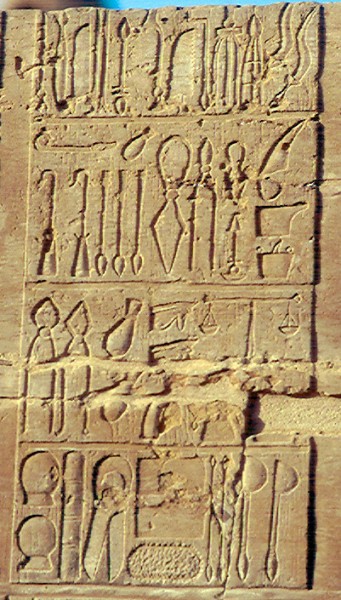
Egyptian Medical Instruments
A belief in magic was deeply ingrained in the Egyptian culture and was considered as natural and normal as any other aspect of existence. The god of magic was also a god of medicine, Heka, who carried a staff entwined with two serpents. This symbol was passed on to the Greeks who associated it with their god of healing, Asclepius, and which is recognizable today as the caduceus of the medical profession. Although the caduceus no doubt traveled from Egypt to Greece it originated in Sumer as the staff of Ninazu, son of the Sumerian goddess of healing Gula.
Besides Heka, there were a number of other important healing deities such as Sekhmet, Serket (also known as Selket ), Sobek, and Nefertum. The priests of Serket were all doctors, though not every doctor was a member of her cult. Serket and Sekhmet were regularly invoked in magical spells and incantations along with Heka and, in certain cases, other deities such as Bes or Tawawret (usually dealing with fertility/children's diseases). Sobek, the crocodile god, seems to have been largely invoked for surgeries and invasive procedures. Nefertum, the god of perfumes associated with the lotus and healing, was invoked in procedures which today would be recognized as aromatherapy. In the Kahun Papyrus a course regularly prescribed for women is to fumigate them with incense to drive out an evil spirit and Nefertum would have been called upon in these instances.
Along with spells and incantations, the Egyptian doctors used naturally occurring herbs and spices as well as their own creations. Bunson writes:
The pharmaceuticals of the ancient Egyptian priest-physicians included antacids, copper salts, turpentine, alum, astringents, alkaline laxatives, diuretics, sedatives, antispasmodics, calcium carbonates, and magnesia. They also employed many exotic herbs. All dispensing of medicines carefully stipulated in the medical papyri, with explicit instructions as to the exact dosage, the manner in which the medicine was to be taken internally (as with wine or food), and external applications. (158)
Surgical procedures were common and many instruments have been identified which are still in use today. The Egyptians had a flint and a metal scalpel, dental pliers, a bone saw, probes, the catheter, clamps for stopping blood flow, specula, forceps, lancets for opening veins, sponges, scissors, phials, bandages of linen, and scales for weighing the proper amount of raw materials to mix for medicines. Surgeries were frequently successful as evidenced by mummies and other remains found who survived amputations and even brain surgery for years. Prosthetic limbs, made usually of wood, have also been found.
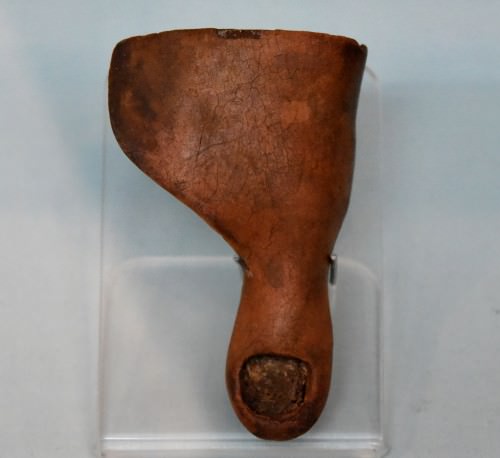
Prosthetic Toe of Painted Cartonnage
CONCLUSION
Not all of the medical practices in Egypt were so successful, however. Circumcision was a religious ritual performed on boys between the ages of 10 and 14 marking the transition from adolescence to manhood. It was performed by a doctor who also served as a temple priest, using a flint blade and reciting incantations, but in spite of their precautions this procedure still sometimes resulted in infection. Since the nature of the infection was unknown to them, it was considered the result of a supernatural influence and dealt with through magic spells; this most likely resulted in the deaths of many young men.
Because of their belief in the womb as connected to all parts of a woman's body, fumigation of the womb was a common prescription, accompanied by incantations, which would miss the actual cause of the problem. Eye problems were treated with a dose of bat's blood because it was thought the night-vision of the bat would be transferred to the patient; no evidence suggests this was effective.
Although the embalmers of Egypt no doubt came to understand how the organs they removed from the body worked with each other, this knowledge was never shared with doctors. These two professions moved in completely different spheres and what each did within their own job description was not considered relevant to the other. It is for this reason that, even though the Egyptians had the means of exploring internal medicine, they never did.
The heart, though recognized as a pump, was also thought to be the center of emotion, personality, and intellect; the heart was preserved in the deceased while the brain was scraped out and discarded as worthless. Although they recognized liver disease they had no understanding of the function of the liver and while regularly dealing with miscarriages and infertility, had no understanding of obstetrics. The culture's reliance on supernatural assistance from the gods prevented them from exploring more immediate and practical solutions to the medical problems they encountered daily.
Still, the Egyptian physician was widely respected for their skill and knowledge and was called upon by the kings and nobility of other nations. The Greeks especially admired the Egyptian medical profession and adopted a number of their beliefs and techniques. Later famous physicians of Rome and Greece - like Galen and Hippocrates ("father of modern medicine") - studied the Egyptian texts and symbols and so passed down the traditions to the present day.
LICENSE:
Article based on information obtained from these sources:with permission from the Website Ancient History Encyclopedia
Content is available under License Creative Commons: Attribution-NonCommercial-ShareAlike 3.0 Unported. CC-BY-NC-SA License